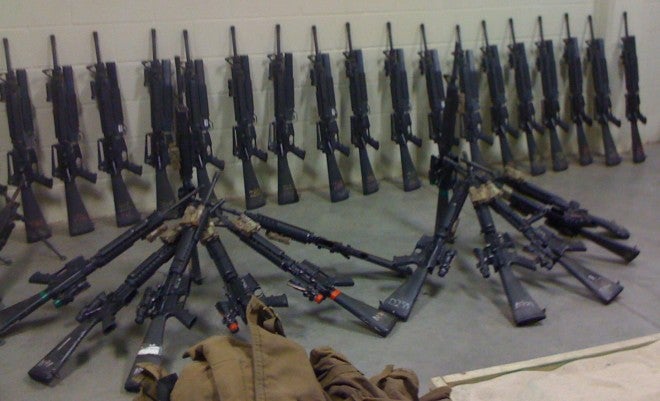The U.S. Armed Forces have alot of guns. Let me correct myself, the military has A TON of guns. Where are all these kept and stored though? In armories of course. But these mysterious enclaves filled to the brim with boy toys must be an absolute joy to even step inside right? Well, maybe if you like paperwork. And I can say that, because I spent two months in one as an Armory Custodian.
But wait Miles, your bio says you’re an infantryman? What is this? Some sort of forged service exploits on TFB to rival that of SEAL faker A.J. Dicken? I’ll get to that part.
For the purposes of this post, I’ll be talking specifically about the U.S. Marine Corps armories that service Infantry Battalions. There are all sorts of armories in the Marine Corps, depending on what type of unit they’re servicing. For example, the armories that are attached to rifle qualification ranges (the Marine Corps has very specific ranges that Marines qualify with their M16A4/M4/M27s at, it’s not like popping down to the local 500 meter range), such as at Stone’s Bay that serves Camp Lejeune/Geiger, MCAS New River/Cherry Point are organized to compliment the range. So when a unit or several units reach that time of the year where they need to qualify, they’ll load up all the Marines living in Bachelor Enlisted Quarters (BEQ aka, a Barracks, or “Bricks” for short), bus them over to the qualification range, book them into the barracks there, and most importantly check their rifles into the armory there. This is a temporary weapon check in because it’ll only last a week or two, until the unit is done with qualification. Other armories serve units that don’t actually require small arms in their day to day military occupational specialities. So cooks, mechanics, and admin Marines for example. These Marines don’t go on field training operations as a part of their regular job very much and thus don’t require a specific weapon signed out to them. But they still have to qualify like every other Marine so once a year they all get in line at these non specific armories, sign out a weapon, and go to the range. Going on deployment or being on an LHD for a MEU is a whole other world, and thus I won’t describe it here as my focus is the armories of an Infantry Battalion.
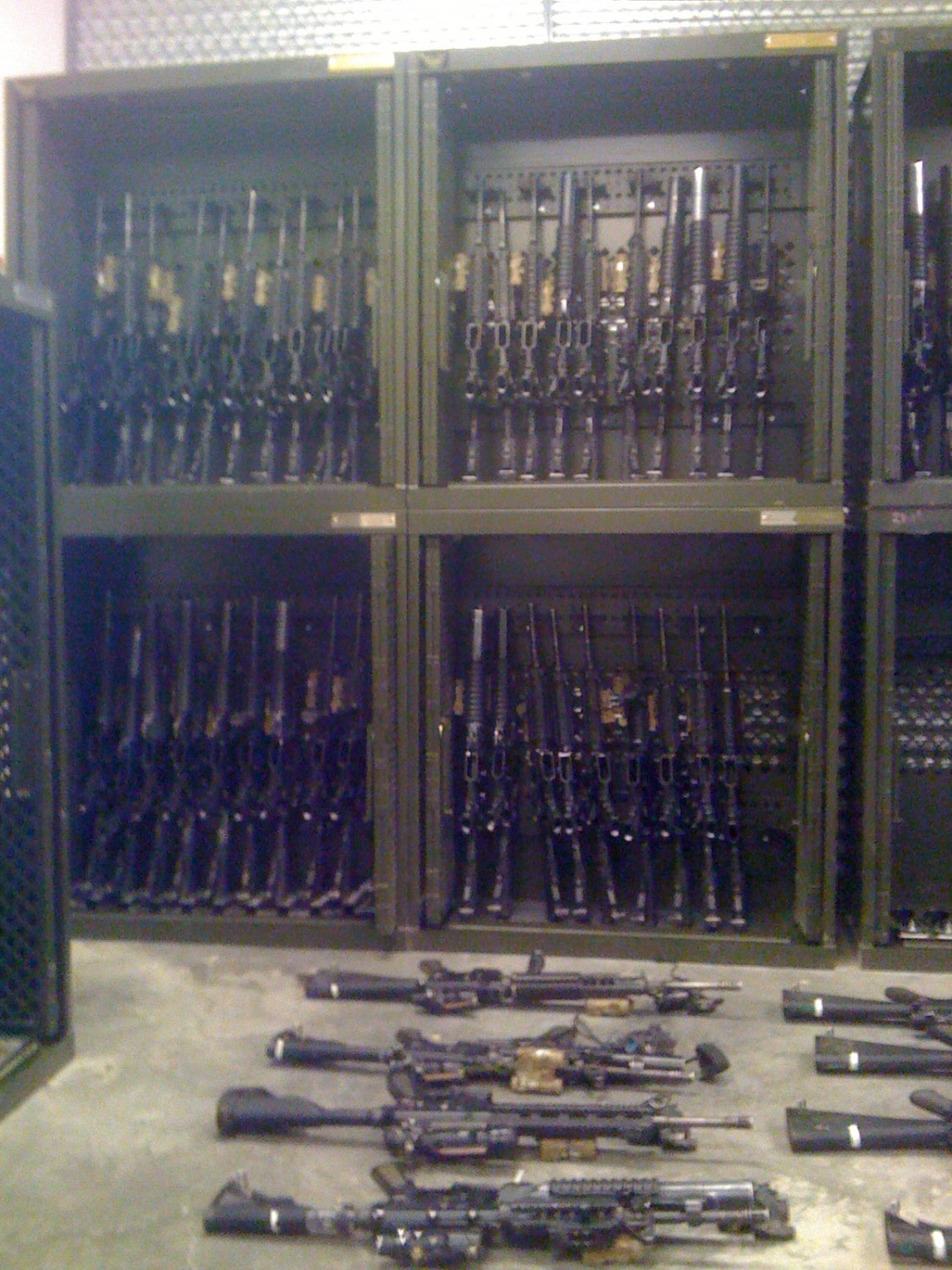
The inside of an Armory during a period of reorganization. The weapons on the floor are yet to have a rack number assigned to them. A good custodian will know to dry fire every weapon before it gets racked so the stress on the hammer springs doesn’t build up, but oftentimes weapons will go on the racks cocked, because Marines will turn them in with the bolt locked to the rear.
This is the Marine Corps’ job description of a 2111, commonly known as an Armorer:
Small arms repairer/technician in the grade of Private through Lance Corporal, under supervision, performs basic duties incident to inspection, maintenance, and repair of all small arms, less vehicular mounted weapons. The small arms repairer/technician also completes basic shop administrative forms and records utilizing technical manuals. At the Corporal through Gunnery Sergeant level the small arms repairer/technician performs, trains, and supervises various duties incident to inspection, maintenance, and repair of all small arms, to include vehicular mounted small arms. The small arms repairer/technician also prepares, maintains, and supervises a shop maintenance and management program and coordinates maintenance and repair of small arms according to grade.
The Department of Labor equates this with being a “Gunsmith”, and the description isn’t really that far off. A 2111 can progress to become a 2112, which is pretty much a “Master Armorer”. These are the Marines at the Precision Weapons Section in Quantico who build the M40A5 sniper rifles and tune up the shooting teams match service rifles and handguns. A very sought after job among 2111s, but there’s a long process to become a 2112, to include months of apprenticeship and a very difficult series of tests that they must pass. In the meantime, most 2111s serve out their enlistments at the aforementioned armories.
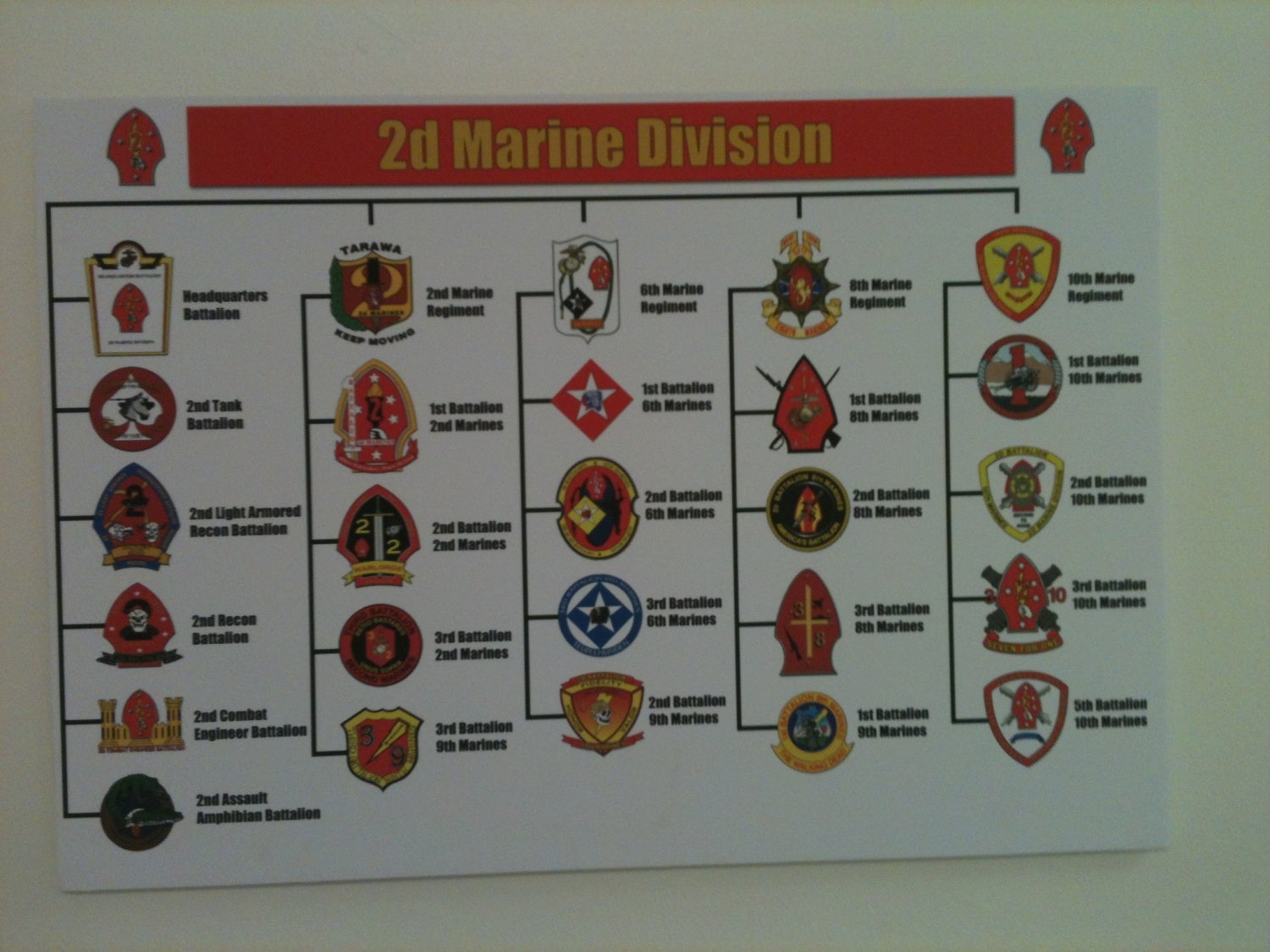
A chart showing all the battalions or unit and how they’re organized within the 2nd Marine Division, which is based at Camp Lejeune, North Carolina, or CLNC for short. There’s really only three Infantry Regiments- 2nd, 6th, and 8th. There is no 9th Marine Regiment as the battalions are split up between these three. My former battalion, 1st Battalion, 9th Marines “The Walking Dead” was apart of the 8th Marine Regiment. We disbanded in August of 2014. The 10th Marine Regiment is composed of artillery battalions and the Headquarters Battalion is a water shed unit to cover various others such as 2nd Recon, 2nd Tanks, 2nd LAR, 2nd CEB, and the Assault Amphibious Battalion which uses AAVs. Notice this presence of “2nd” in many of these, including the division. The West Coast is all 1st, so 1st Marine Division, 1st LAR, 1st Recon, and so on. 3rd is in Hawaii or overseas, with 4th being anything reserve. So 4th Recon, 4th LAR, are all reserve units in the United States.
But here’s the catch. You would think that an “Armory” would be filled with “Armorers” right? Wrong. The job of an “Armorer” (or its less glorious brother MOS, that of a 2171 Optics Technician) is as stated above, to mostly repair and maintain the weapons of an Infantry Battalion. Weapons don’t need to be fixed or repaired for most of their service life, so in the meantime, how are they accounted for? How are they stored? Who makes sure each weapon is assigned to each specific Marine? Ahhh, not the Armorers! That’s not in their job description (If you can’t tell already, there is much animosity between 03 Armory Custodians and 2111 Armorers). Well who owns and uses the weapons? The Grunts of course! So, the burden of keeping an armory stocked and accounted for falls onto the shoulders of the 03 Marines in their various line companies. These Marines are known as “Armory Custodians” (which is not an MOS). And yes, they do happen to do a lot of sweeping and mopping (E3 and below of course).
As my first deployment to Helmand province was coming to an end, word got around that the company was looking for new armory custodians and somehow without my choice in the matter my name came back to the PB I was on. I was mad, I was furious, I didn’t enlist to count weapons, I enlisted to go to war. Later on, I learned the back story of how I was picked. It was because the company XO originally told my buddy that he was going to be picked to be a custodian. He in turn, almost freaked out and said that he would go crazy in an armory. The XO then asked him who he had in mind instead. And my name was dropped, and just like that, the bus smeared me into the concrete. But it was a blessing in disguise, because when the Scout Sniper platoon ran an indoc two months after we got back from Afghanistan, I jumped on it and the wretched armory was my motivation to pass the indoc and get into the platoon (incidentally, I got a chance to attend the Basic Course, but failed, so remained a PIG).

The infamous Trijicon RCO with the bible scripture scratched off. The zipties on the right are to keep the scope attached to the weapon if it comes loose and falls off while in the field or deployment. Some units use 550 cord or steel wire for the same purpose. The elastic band was formally attached to a honeycomb anti reflective device that isn’t pictured as it has broken off.
Potential Armory Custodians are an odd bunch for a number of reasons. A good company commander knows that he has to have good armory custodians, and a good gunnery sergeant will tell that to his face (Marine Gunnies are usually responsible for all the small arms, but the company commander has the ultimate responsibility). Equipment mishap story’s in the Marine Corps are the stuff of legend. Marines have been disciplined severally for the loss of a single piece of equipment, even to the point of court martial and loss of rank. It is almost a worst nightmare when a Marine comes up short on the EDL. EDLs are basically lists of every single “serialized” and unserialized (usually if something is unserialized, it can be bought on the civilian market and replaced if lost, but you can’t replace something that has a unique serial number) piece of equipment that is issued out to a company, platoon, squad, even down to the individual Marine. I’ve seen entire field ops halted for days at time, just to look for a set of PVS14s that a Marine dropped somewhere. Never mind losing a weapon, try keeping track of something the size of a calculator among a hundred other things you have to hold on to. To help mitigate this, a platoon sergeant or squad leader will do constant EDLs, as much as possible. Most often these are done before a troop movement so if something is lost, the first step is to trace it back to the last time it was noted on an EDL. This is where the cover ups sometimes happen. A Marine doesn’t know where his NVGs are but is convinced they’re somewhere and his fire team leader might cover for him while he goes looking. This doesn’t happen often but when it does, it complicates the search even more and can cause even worse penalties.

An M27 charging handle taken apart to show how the parts can be flipped to account for left handed shooters. This is beyond field disassembly and thus against regulations in that it is second echelon maintenance, but I did it anyway.
But I digress, the company knows that the armory has to be staffed by capable and smart Marines. But you can’t take your best squad leader and stick him in the armory for the sake of better equipment management. So this is the conundrum that faces the staff NCOs of the company, because they need a capable Marine in the armory, but nobody wants to be in the armory in the first place (the job is even mentioned on the Terminal Lance forum titled Most Useless Billet), and they don’t want to give up their junior NCOs. So the guys that get stuck in the armory are an odd bunch. Oftentimes a company will stick Marines in the armory who aren’t very capable in their original 03 jobs or if they’re going through problems. But wait, am I really suggesting that someone with mental problems or otherwise be in the armory? That’s actually the best place for them (ammunition is not stored in the armory), that or the admin side of the unit. The reason is that it gets them away from the company, away from dealing with everyone else on a day to day basis that they may have trouble with. Another source of Armory Custodians is volunteers, and 03s do routinely volunteer for these jobs. Because being an Armory Custodian is pretty straight forward and even easy. You’re not with the company doing whatever the company is doing but sitting in a CLP smelling, nice air conditioned room while they’re out doing classes or running around doing drills. In my case, the company I was in badly need of good Marines in the Armory because the previous ones didn’t have the best of luck in managing it.
An Infantry Battalion consists of five companies, three line companies, one weapons company, and a headquarters and service company. Thus a typical Battalion armory will have six “bays”. One for each company and a sixth one that is the maintenance bay. This is where the 2111s and Optics Techs do all the actual work on the weapons. Most of the work that they do is what is called first echelon maintenance. If you have an image of a 2111 reboring an M16A4 or machining some part, this is very mistaken. Most of what they do at this level is switching out parts, checking the headspace, and conducting service life tests. Anything that requires actual gunsmithing is usually sent back for second or third echelon maintenance. Not to say that the 2111s aren’t talented or don’t know what they are doing, but they are adhering to a set of echelon standards that are set specifically for them. As an example on my second deployment a kid left his M4 against an MRAP and it thus got run over and the barrel was bent. The 2111 changed out the barrel for a stock one but he didn’t have the tools or authority to straighten it, that’s for a higher echelon.

An SOI companies worth of PVS14s and their assorted SL3 accessories laid out for counting. Sights like this are an every day occurrence in an armory.
As an Armory Custodian, the most important job is that of the “Site Count”. This is an inventory done at the end of every work day and is especially important because the work day does not end until the Site Count is “Up”. This means that the custodians have to physically count every single piece of equipment inside their bay, mark the numbers down and give it to the company commander (or company XO in many cases). The CO will have his own site count sheet and will match the two together. You had better hope that all the numbers on your site count match up to those on the COs or else you’ll have a whole company of angry Marines waiting to get off work. Because there is from two to five armory custodians in a single company bay, usually the chief custodian will have his site count sheet and the others will go around and count every single item. So the chief will call out “M16A4s” and a custodian (or two, if extra care needs to be taken) will say his number, maybe “sixty five M16A4s”. The chief will compare the two number counts and if they match, he’ll move on to maybe “PEQ16s”. This sounds simple but if you take into account that an average 0311 will be issued an M16A4, RCO, PEQ16, Bayonet, and a PVS14. Multiply this by about 180 to 200 Marines in a company and you easily have over one thousand individual pieces of gear that need to be accounted for. This isn’t even including the M249s, M240s, M9s, PVS24s, PAS28s, PVS17Cs, compasses, Laser Bore Sights, M203 grenade launchers, PEQ15s, M4s, Vectors, M22 binoculars, DAGRs, and tripods. On a deployment it gets even more tedious because of all the additional equipment that gets assigned to a particular unit.
In addition to the site count, the other large inventory procedure is something called a CMR. This is usually done at the battalion level but it comes down from the division or regiment that it falls under. The CMR is a master computerized list that shows every single item that a particular unit is accountable for. These aren’t simple count and match affairs, but usually an outsider such as an officer or staff NCO will come in and go through every single item by serial number. That’s right, each individual serial number will be read out and confirmed before moving on to the next item. A typical CMR can last up to a whole week because every bay has to be accounted for. There’s also LTIs/PFIs which are performance checks that the 2111s do on a bays weapons or NVGs. In this case the custodians don’t do anything, because the 2111s go through every weapon and piece of equipment and function check it. If it needs to be taken away for servicing, then the proper paperwork has to be filled out.
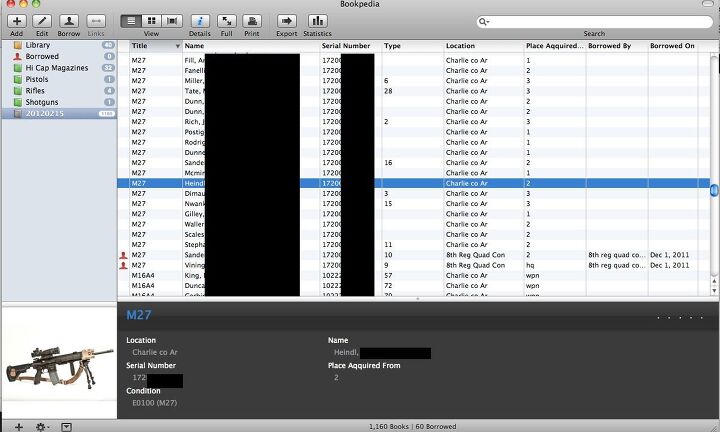
The program I used to catalog the various small arms and equipment, a Mac library program named Bookpedia. This really helped out a lot when looking for a specific item or several and seeing where they were. We could also organize things by platoon as is shown by Place Acquired (1st, 2nd, 3rd, Weapons, and HQ). The picture of the M27 isn’t of Heindl’s particular M27, but a generic picture to help in referencing. You can also download it as an app for your iphone or ipod. I still use it today to catalog and record all of my personal firearms and magazines. I highly recommend it when going to gun shows and making sure you’re not buying the same magazine you might already have.
Each custodian has their own method to organizing and keeping track of what they have in their armory. Typically this will consist of a “Bible”, or a large book that lists every item by serial number. I pioneered the use of a Mac library program where I listed each piece of equipment as a book and had its details typed up in it. So when Marines would sign out weapons or they would be taken away for service, the “books” would be checked out into whatever category they were going to, and then returned when they came back. Needless to say, this system stopped working after I left and the new custodians went back to their old ways. Small arms are usually organized by either serial numbers, names of the Marines they are assigned to, or by units. So all of first platoon will occupy one rack while second platoon will occupy another. Each system has advantages and disadvantages. Then rack numbers will be assigned, this is by taping or stenciling the number to the rack slot and then on the piece of equipment as well. So when Cpl. Gross hands in his card, I look for his rack number which is 57 and I simply find rifle number 57 and hand it out to him, while placing his card in the 57 empty slot. When Cpl. Gross comes back with his rifle, I take the rifle, place it in the slot, and return his weapon card to him.
Okay so apart from counting, it seems easy enough? Wrong. A company armory isn’t in a static period of existence. Weapons and equipment are constantly coming in and being checked out. Individual platoons will go on field ops, certain Marines will go to the range, squads will check their weapons out to do dry fire drills with them. Weapons get broken and have to be signed out for repair, other weapons that have been fixed or serviced are coming back in, units are constantly switching out small arms with each other, so 2/8 will have an abundance of M16A4s and thus give them to 3/6. All these changes are fluid and are happening on a day to day basis if not an hourly one, especially if the Battalion is in a deployment work up. By the end of the day, if one single piece of equipment turns up missing or the counts don’t add up, the whole staff will go into a frenzy looking for it, even to the point of pulling every single serialized item out by serial number or rack number. This becomes very stress induced because as mentioned before, the penalties for a lost piece of serialized equipment are very severe.
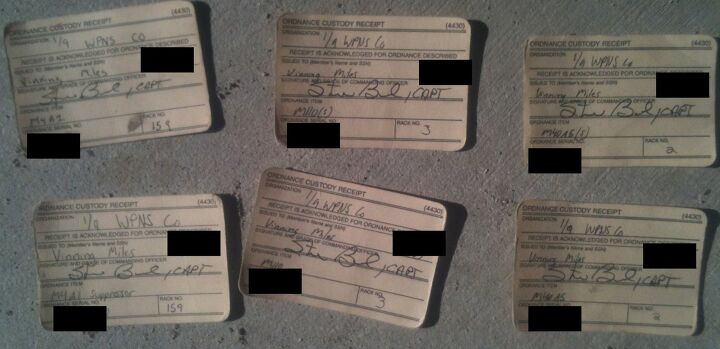
These are my issued weapons cards when I was in the 1/9 Scout Sniper platoon. The blacked out items are the serial numbers of the weapons and my social security number. With the Sniper rifles, a card isn’t made for the scopes because they stay mounted to the rifle, unlike M16A4s and M4s which often see scopes moved around alot. The (S) on some of them are for the Surefire suppressors. Since Vietnam, Sniper platoons have had a back and forth movement between being placed in the Headquarters and Support company and the Weapons company. The logic behind the H&S company placement is that ultimately, the platoon works for the Battalion commander and S-2 Intelligence shop because of their unique capabilities. The logic behind placing them in the Weapons Company is that they’re 03s and don’t belong around H&S in the first place, and that when the entire battalion goes into the field, it’s easier to tag along with Weapons because they already have everything set up to get out there, whereas most field ops H&S company doesn’t even go on.
So how do these weapons get actually “checked out” by the Marines whom they are assigned to? Each Marine gets a weapons card with information about that piece of equipment on it. It’ll say the serial number and rack number in addition the name of the Marine it is assigned to, as well will have a corresponding weapons card number that is logged in a book. These cards aren’t just randomly written up and issued out, they have to be signed by the CO or XO and losing them is almost on the same level as losing a military ID or meal card. I don’t think a week doesn’t go by where a Marine will inadvertently mash up all his cards by putting them in the washer. Regardless, bays have a small window that is about a foot square which can be locked from the inside. A platoon or the entire company will line up outside the window and wait to get their weapons and equipment. This is one of the biggest points of friction in training, because it is delaying any training that comes after it. Thus armory draws are routinely done at early hours in the morning to get the company moving by daylight. An efficient and fast working custodian team can have an entire platoon done within twenty minutes. So not only do custodians have to find a Marine’s rifle, but they also have to find his NVGs, and any other equipment that his billet requires. However, if one card is out of order, one rifle in the wrong rack, then it can take hours to sort out and often under the fire breathing NCOs that are yelling at the poor custodians to hurry up.

This is the M4 coupled with an M203 that I carried in Afghanistan. Everything that comes issued with the rifle is attached to it, everything that I added to it is laid alongside it, apart from the magazine and rounds. Not pictured is the LMT SOPMOD buttstock. The Badger Ordnance charging handle I picked because the increased ability to rack the bolt back with just the palm of my left hand. The Wilcox mount was used to mount thermal imaging UTMs in front of the RCO. The Hogue grip was especially nice with the over molded extension, I absolutely hated the stock pistol grip. The BAD lever is a huge boon because of how many times you have to clear or load your weapon while on deployment, not to mention fixing a double feed during a firefight (H&K magazine). The RM Equipment handle was great because I could get a firm grip on front portion of the weapon instead of holding the grenade launcher handguard. Although a two point sling was mandated, I fashioned two clips to it (as seen above) so while on Camp Leatherneck I would have a two point, but when we went on patrol, I unclipped the sling and clipped the rifle to my plate carrier to make a one point.
So what about personal options on issued service rifles? The general rule of thumb among Infantry Battalions (tsk tsk MARSOC and Recon) is that the weapon must come back into the armory the way it was issued out, and that is absolutely bare. So slings, forward grips, bipods and anything else has to be taken off the rifle before it comes back in. Some Marines (this one included) danced on the fence by adding Magpul BAD levers, aftermarket charging handles, and stocks. But we kept the stock pieces in a safe place in our gear and when we turned the weapons back in, we quickly replaced the aftermarket parts with the stock parts. And scopes? In my three and a half years of being in a line company, I’ve only ever seen two Marines who had their own scopes mounted on their rifles. One had an EoTech, and the other had an Aimpoint reflex sight and a magnifier. Both of them were NCOs and thus had a little more leeway. Both had to zero their service rifles to their scope of course. This may seem odd that the Marine Corps looks with disdain on Marines who want to make their rifles better, but considering that taking out your trigger assembly is a punishable offense, it’s right in line.
Being picked to be a custodian, I initially was somewhat optimistic. Nice! I’ll get to spend all my time around guns and learn more about them. Nothing could be further from the truth. I think I’ve learned more about different versions of the M16A4 through pictures than through handling hundreds of them over a period of multiple days. The small arms cease to become interesting and instead become inanimate objects and items of hatred because of how they confound you by not being able to find a specific one or several individual ones. You don’t even get to shoot them anymore!

One of the more more interesting weapons in an armory. This FN M4 initially started out as a standard issue M4 carbine in Burst. It was converted to become an M4A1. This simply means that the fire control group was changed out with an Automatic sear, and the markings of “Burst” and “M4 Carbine” were machined off and stamped with “Auto” and “M4A1 Carbine”. The charging handle was also switched out to a Gunfighter charging handle, as well as the compensator was replaced with a Surefire Suppressor compatible one.
But being a custodian did have some perks. I was able to get pistol qualified as a Lance Corporal because the job requirement of being be armed with a loaded M9 while on duty or escorting large amounts of weapons outside of the armory. Bear in mind a pistol qualification is usually only afforded to NCOs, officers, and those who are issued a pistol, which is a very small portion of the Marine Corps. I was able to get a security clearance faster because working in an armory requires dealing with large amounts of high value equipment. It gave me an insight into being inside a Marine armory, and most importantly it gave me the motivation and push to try out for the Scout Sniper platoon indoc, a decision I have never looked back from.
 Your Privacy Choices
Your Privacy Choices
